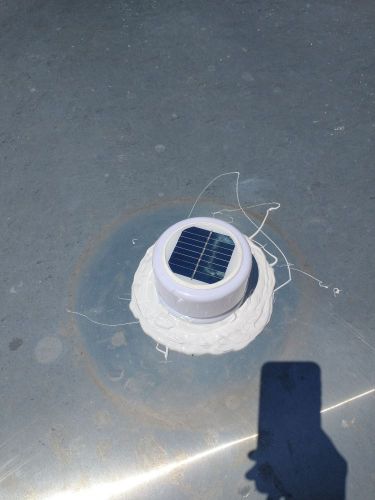Your tanks stink to high heaven. Gray or black, doesn’t matter. All wastewater RV tanks smell like an overflowing public latrine at a county fair on a hot summer day. Don’t take it personally; everyone else’s tank smells the same way.
Tank odors are caused by natural anaerobic bacteria. You can reduce the offending smells by properly cleaning your tank and adding holding tank chemicals or enzymes, but the smell can only be mitigated, not eliminated.
There’s a simple, $15 part that will get rid of most RV tank odors. But before we get to that, let’s get to the bottom of the problem. (Not literally, of course.)
Here’s Why Your RV Smells Like a Waste Tank
Problem #1: Odors don’t always stay where they are supposed to. In the perfect world, P-traps block sewer gases from escaping into the living area. In the perfect world, AAVs (Air Admittance Valves) can only open under negative pressure. In the perfect world, the ABS pipe and fittings that make up your vent stack are 100% airtight.
Unfortunately, we swallowed the red pill. We are forced to deal with reality. Most RV holding tank systems have small air leaks, like loose pipe fittings or dry P-traps. Tank odors seep into your RV through these cracks. And when driving down rough roads, water can slosh out of P-traps and kick open the door to noxious fumes.
Problem #2: Vent stacks don’t always do their job. The primary purpose of a vent stack is to equalize pressures; the secondary purpose is to circulate fresh air. They don’t always do their second job well, so stale air stays stuck in the tanks, where the smell concentrates. They are protected by simple caps, like the ones below, that don’t help circulate any air.

How to Get Rid of RV Tank Odors
There’s a fairly simple product that will fight as your righthand man against bad tank odors.
Actually, there are a handful of products, all called fume extractors. There are three popular options on the market, plus a few knockoffs:
- Lippert 360 Siphon
- Camco Cyclone
- Ultra-Fab Solar Plumbing Vent
These products replace the standard RV plumbing vent, which looks like this (see above.) The typical plumbing vent is nothing more than a bit of screen and a plastic cover to keep rain and critters out. More on these later.
The Lippert 360 Siphon vent cap is probably the best-known of the bunch. It’s a clever piece of molded polycarbonate, sold in white or black. There are no moving parts. When a breeze passes over the cap, it generates an updraft which pulls odors out of the vents. So it works whether you’re moving or stationary – so long as there’s a breeze.

The Camco Cyclone vent cap is an inventive competitor to the 360. It uses a small fan rather than the Ventouri effect to generate an updraft. The fan pivots to align with the wind, and the mechanism doesn’t have to be screwed into the roof; it can slide on top of the vent pipe itself. They’re nifty, but they have a reputation for getting in fights with tree branches (and losing).

The popularity of the Siphon 360 vent cap has spawned a slew of riff-offs and knock-offs: the AP Products Xtreme roof vent, the Chafee Engineering RV sewer cap, and a host of others. Most are based on the Ventouri or Bernoulli principle, where moving air generates a difference in pressure.
Unlike the Siphon 360 and Camco Cyclone, the Ultra-Fab Mini Solar Plumbing vent cap requires electricity. But you don’t need to run wire; the vent cap has its own mini solar panel! The upside of this design is that the fan can run without a breeze. The downsides are that A) it’s more expensive, B) the motor can be noisy, and C) there’s no battery; the unit requires direct sunlight.

Now, if you’re an astute DIY plumber, you might be wondering, “If air is coming out, then where is air going in? Aren’t the tanks supposed to sealed?”
You’re not wrong – in theory. But here in the land of reality, there are usually enough leaks in the system to allow air circulation. Plus, AAVs can open under negative pressure.
How to Install a 360 Siphon Vent?
I won’t bore you with a detailed description of how to replace your plumbing vent cap. The best tutorial I’ve found is from LoveYourRV.com. You can read it here.
You can also watch a video tutorial by the RV Geeks, one of my favorite RV bloggers. I’ve embedded it below.
Why Don’t All RV Manufacturers Install the 360 Siphon Vent Standard?
I’ll take a crack at an answer, but remember, I can’t and don’t speak for all RV manufacturers!
First of all, many manufacturers do install Siphon or Cyclone vents standard! It’s just not something you’ll find advertised on a sales brochure. It’s a common factory-standard feature on most premium brands.
As for why it’s not installed on bargain basement brands, then I dare guess it’s because it won’t pay for itself. If you’re selling based on the lowest price, then every part must pay for itself. If the extra $15 for a Siphon vent doesn’t generate an extra $15 in sales, then it’s a net loss. That’s a harsh truth, but truth nonetheless. If you don’t like it, vote with your dollars, and choose the brands that prioritize quality over cost.
Leave a Reply